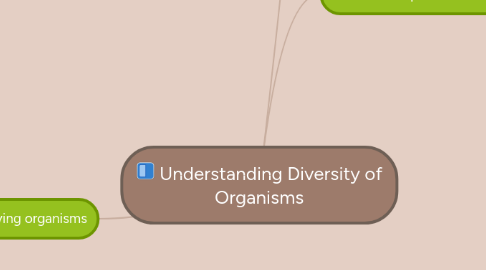
1. lesson 5.1 the variety of life
1.1. lesson trigger
1.1.1. the Barbados Threadsnake is the world's smallest snake
1.1.1.1. discovered in the forest of Barbados
1.1.1.2. longest Barbados Threadsnake is only 10.4 cm and only as thick as a spaghetti
1.1.2. There is currently more than 2,900 kind of snake known to the world
1.2. Each year, scientists discovers many new kinds of organism
1.2.1. As of 2011,scientists estimated that there could be about 8 million kinds of organism on Earth.
1.2.2. Scientists have cataloged about 2 million species of organism on Earth.
1.2.3. existence of many kinds of organism is called biodiversity
1.3. variety within smaller group of organisms
1.3.1. there are many variety of animal on earth but variety do not exist within organism as a whole
1.3.2. variety also exists in smaller groups of organisms
1.3.2.1. different dogs belong to same canine family but they look different.
1.3.2.2. broccoli and cauliflower belong to same family but the look and taste different.
1.3.2.3. different kind of chicken belong to same bird family but they look different.
1.4. there is actually about 40,000 types of spider on Earth!
2. Lesson 5.3 classifying organisms
2.1. lesson trigger
2.1.1. Why do we classify organisms?
2.1.1.1. Krishnan was given an assignment to identify how insects are related to one another.
2.1.1.1.1. First, he classified them based on the presence of wings. Then he classified them into subgroups.
2.2. How do scientists classify organisms.
2.2.1. A dichotomous key is used by biology scientists.
2.2.1.1. A dichotomous key shows how objects or organisms are classified according to how their are similar or different.
2.2.2. we use dichotomous key to classify and identify organisms.
2.2.2.1. For example, we can use the key to classify the students.
2.2.2.1.1. First, identify the main difference between the students which is the gender.
2.2.3. Scientists classify organism into 5 groups called kingdoms..
2.2.3.1. Each kingdoms has different characteristics.
2.2.3.2. Plants are classified into 2 main groups, flowering and non-flowering.
2.2.3.3. Animals are classified as with backbone and without backbone.
2.3. Bacteria
2.3.1. Cannot be seen with our naked eyes and is found everywhere.
2.3.2. Different bacteria can be harmful and beneficial.
2.3.2.1. When food containing harmful bacteria are eaten by us, it will cause us to be sick by food poisoning.
2.3.2.2. Bacteria can be beneficial to us in water treatment, food production and digestion.
2.3.2.2.1. Water treatment
2.3.2.2.2. Food production
2.3.2.2.3. Digestion
3. lesson 5.2 importance of biodiversity
3.1. lesson trigger
3.1.1. why is biodiversity important in natural system
3.1.1.1. coral reef is rich in biodiversity, supporting about 25% of aquatic lives.
3.1.1.2. if all coral is gone, the diversity and balance of life in the sea will be gone
3.1.1.3. in 1998, a rise of 1-2 deg c resulted in many deaths of corals including those in Singapore
3.1.1.4. coral reefs supports more lives than we can imagine
3.2. natural's system is complex network of different organisms that depends on each other
3.2.1. when a kind of organism no longer exists, the system becomes unstable. The same applies to rain forest and ocean.
3.2.2. biodiversity is important for the stability of systems in nature.
3.3. What is the importance of biodiversity to humans?
3.3.1. Biodiversity is important to maintain a stable system in nature
3.3.1.1. for example, bees help to fertilise corps which are important source of food for human and other organisms.
3.3.1.2. Without honeybees, life on Earth would be hard to sustain as there would be no honeybees to fertilise corps in large scale.
3.3.2. organism found in nature are valuable resources.
3.3.2.1. There are:
3.3.2.1.1. Raw materials like wood
3.3.2.1.2. Food(e.g species)
3.3.2.1.3. Medicines(antibiotic)
3.4. The threads to biodiversity
3.4.1. Disease
3.4.1.1. Plants infected by fungus could be wiped out if the disease spreads.
3.4.2. Excessive hunting
3.4.2.1. Tiger is now endangered by the over hunting of their meat and skin
3.4.3. Invasion of other organisms.
3.4.3.1. In Singapore, the American bullfrog(non-native)eats the smaller local frogs. This threatens the survival of the local frogs.
3.4.4. Change or loss of habitat.
3.4.4.1. Land cleared for industry, farming and housing will cause animals to lost their home and source of food.
3.5. What we can do to preserve biodiversity on Earth?
3.5.1. Conserving wildlife and their natural habitat helps to maintain biodiversity.
3.5.2. Here are some ways we can do our part in conservation.
3.5.2.1. Volunteering with wildlife conservation organisations such as the World Wide Fund for Nature(WWF) and the Nature Society(Singapore)
3.5.2.1.1. The panda, which is an endangered animal, is the symbol of the World Wide Fund for Nature(WWF)
3.5.3. Helping to spread the word of the importance of protecting wildlife.
3.5.3.1. For example, WWF is creating awareness for the conservation of coral reefs which are severely threatened by the weather changes.
3.5.4. Stopping introduction of non-native species into the environment. For example, we should stop releasing unwanted pets into the wild as they might die or breed and/or upset the biodiversity in the area.
3.5.5. Limit usage of natural resources by recycling and reusing material as usage of natural resources will destroy habitats and disturbs the biodiversity in an area.

